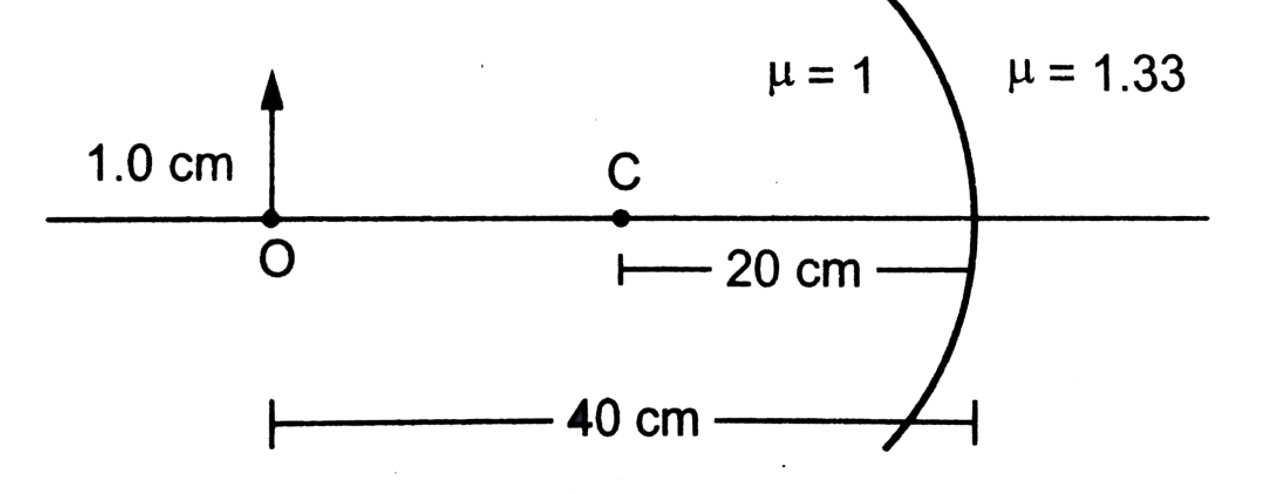
Find the size of the image formed in the situation shown in figure.

A) 0.5 cm
B) 0.6 cm
C) 1.2 cm
D) 1 cm
Answer
216.3k+ views
Hint: In this question, we have to find the size of the image and since all the required parameters are given in the question, we will find the required size of the image by mirror, we will use the mirror formula for two mediums.
Complete step by step answer:
We will now write the given data according to sign convention:
The distance of the object is u = -40 cm.
The radius of curvature of the refracting surface is R = -20 cm.
The height of the object is h = 1 cm.
We know that the lens maker formula is given by:
$\dfrac{{{n_2}}}{v} - \dfrac{{{n_1}}}{u} = \dfrac{{{n_2} - {n_1}}}{R}$
Here, v is the distance of image formed.
Here ${n_2} = 1.33$ is the refractive index of the second medium and ${n_1} = - 1$ is the refractive index of the first medium.
We will now substitute the known values in the above equation.
$\begin{array}{l}
\dfrac{{1.33}}{v} - \dfrac{1}{{ - 40\;cm}} = \dfrac{{1.33 - 1}}{{ - 20\;cm}}\\
v = 32.05\;cm
\end{array}$
We know that the expression for magnification ratio is given by:
$\dfrac{v}{u} = \dfrac{H}{h}$
Here, H is the height of the image formed.
We will now substitute the given and obtained values.
$\begin{array}{l}
\Rightarrow \dfrac{{32.05\;cm}}{{40\;cm}} = \dfrac{H}{{1\;cm}}\\
\Rightarrow H = 0.6\;cm
\end{array}$
Therefore, the correct option is (B).
Additional information: Reflection from a concave mirror follows the laws of reflection. The normal to the point of incidence is drawn along the radius of the mirror, i.e., it is drawn by joining the centre of curvature with the point of incidence.
Note: The formation of an image that occurs in a concave mirror mainly depends on the distance between the object and the mirror. Both real and virtual images are formed by the concave mirror. When the object is placed very close to the mirror, a virtual and magnified image is formed.
Complete step by step answer:
We will now write the given data according to sign convention:
The distance of the object is u = -40 cm.
The radius of curvature of the refracting surface is R = -20 cm.
The height of the object is h = 1 cm.
We know that the lens maker formula is given by:
$\dfrac{{{n_2}}}{v} - \dfrac{{{n_1}}}{u} = \dfrac{{{n_2} - {n_1}}}{R}$
Here, v is the distance of image formed.
Here ${n_2} = 1.33$ is the refractive index of the second medium and ${n_1} = - 1$ is the refractive index of the first medium.
We will now substitute the known values in the above equation.
$\begin{array}{l}
\dfrac{{1.33}}{v} - \dfrac{1}{{ - 40\;cm}} = \dfrac{{1.33 - 1}}{{ - 20\;cm}}\\
v = 32.05\;cm
\end{array}$
We know that the expression for magnification ratio is given by:
$\dfrac{v}{u} = \dfrac{H}{h}$
Here, H is the height of the image formed.
We will now substitute the given and obtained values.
$\begin{array}{l}
\Rightarrow \dfrac{{32.05\;cm}}{{40\;cm}} = \dfrac{H}{{1\;cm}}\\
\Rightarrow H = 0.6\;cm
\end{array}$
Therefore, the correct option is (B).
Additional information: Reflection from a concave mirror follows the laws of reflection. The normal to the point of incidence is drawn along the radius of the mirror, i.e., it is drawn by joining the centre of curvature with the point of incidence.
Note: The formation of an image that occurs in a concave mirror mainly depends on the distance between the object and the mirror. Both real and virtual images are formed by the concave mirror. When the object is placed very close to the mirror, a virtual and magnified image is formed.
Recently Updated Pages
Wheatstone Bridge Explained: Working, Formula & Uses

Young’s Double Slit Experiment Derivation Explained

JEE Atomic Structure and Chemical Bonding important Concepts and Tips

JEE Amino Acids and Peptides Important Concepts and Tips for Exam Preparation

Electricity and Magnetism Explained: Key Concepts & Applications

Chemical Properties of Hydrogen - Important Concepts for JEE Exam Preparation

Trending doubts
JEE Main 2026: Application Form Open, Exam Dates, Syllabus, Eligibility & Question Papers

Derivation of Equation of Trajectory Explained for Students

Hybridisation in Chemistry – Concept, Types & Applications

Understanding the Angle of Deviation in a Prism

Understanding Collisions: Types and Examples for Students

How to Convert a Galvanometer into an Ammeter or Voltmeter

Other Pages
JEE Advanced Marks vs Ranks 2025: Understanding Category-wise Qualifying Marks and Previous Year Cut-offs

Ideal and Non-Ideal Solutions Explained for Class 12 Chemistry

Degree of Dissociation: Meaning, Formula, Calculation & Uses

Understanding Electromagnetic Waves and Their Importance

Understanding the Electric Field of a Uniformly Charged Ring

Understanding Average and RMS Value in Electrical Circuits




